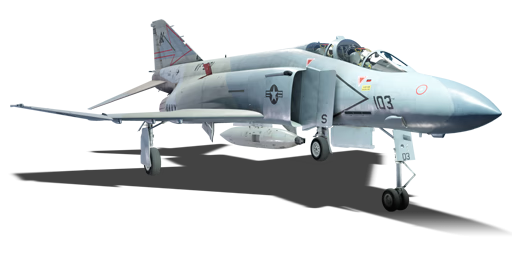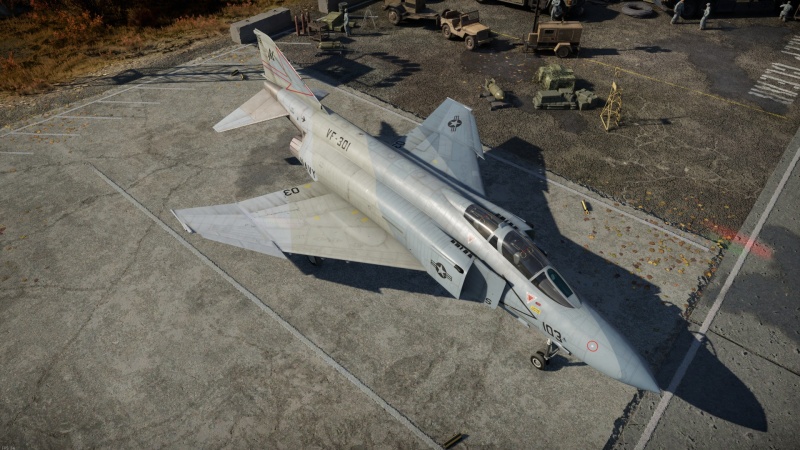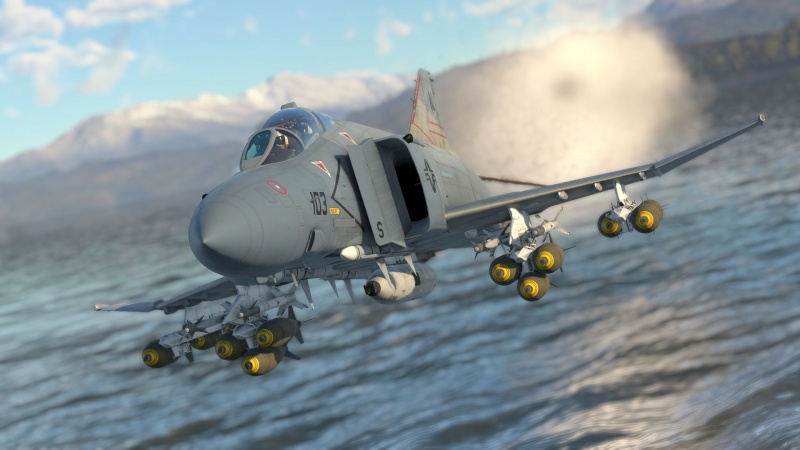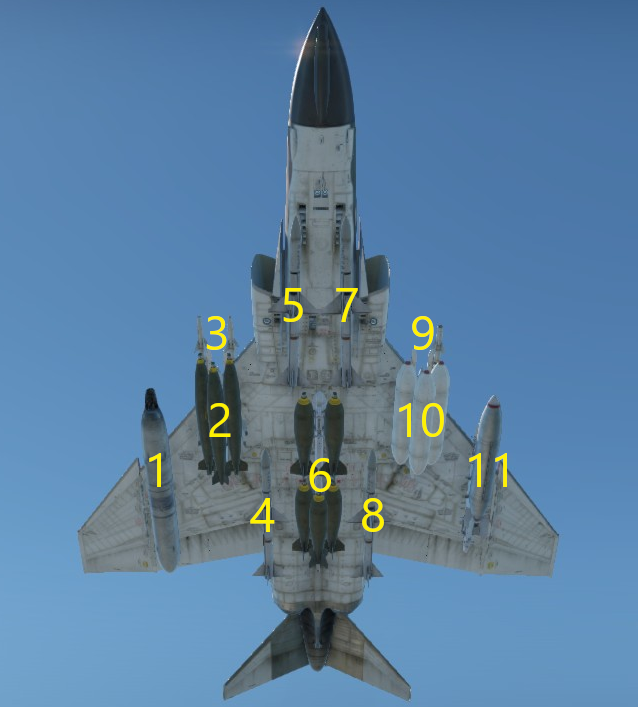F-4S Phantom II
| This page is about the premium American jet fighter F-4S Phantom II. For other versions, see F-4 Phantom II (Family). |
Contents
Description
The F-4 Phantom II served its most notable service period in the Vietnam War for both the US Air Force (USAF) and US Navy (USN). The USN had the F-4J as their latest aircraft, and it began to show its age in the post Vietnam War period. A modernization program began to keep the F-4J up to date with latest upgrades. Improvements were done in avionics, weapon systems, airframe, and undercarriage, but the two most notable improvements were wing leading-edge slats, for improved manoeuvrability, and new smokeless engines. The F-4S flew for USN up until the Phantom's retirement in the late 1980s, replaced by more modern aircraft like the F-14 Tomcat and the F-18 Hornet.
The F-4S Phantom II, introduced in Update "Sky Guardians", is one of the top versions of the F-4 Phantom II in the game. While the overall play style is not very different from the F-4J, the performance improvements in manoeuvrability should allow the F-4S to occasionally get the upper hand over even more modern fighter designs that it can encounter. Outside the dogfighting range, the usual complement of BVR weaponry like the Sparrows alongside the PD radar should allow the F-4S to shoot down careless enemy fighters who can't evade in time.
General info
Flight performance
| Characteristics | Max speed (km/h at 12,192 m) |
Max altitude (metres) |
Turn time (seconds) |
Rate of climb (metres/second) |
Take-off run (metres) | |||
|---|---|---|---|---|---|---|---|---|
| AB | RB | AB | RB | AB | RB | |||
| Stock | 2,080 | 2,058 | 16000 | 26.5 | 27.4 | 155.0 | 145.2 | 850 |
| Upgraded | 2,224 | 2,140 | 25.5 | 26.0 | 217.6 | 185.0 | ||
Details
| Features | |||||
|---|---|---|---|---|---|
| Combat flaps | Take-off flaps | Landing flaps | Air brakes | Arrestor gear | Drogue chute |
| ✓ | ✓ | ✓ | ✓ | ✓ | ✓ |
| Limits | ||||||
|---|---|---|---|---|---|---|
| Wings (km/h) | Gear (km/h) | Flaps (km/h) | Max Static G | |||
| Combat | Take-off | Landing | + | - | ||
| 1458 | 463 | 1,458 | 618 | 463 | ~11 | ~4 |
| Optimal velocities (km/h) | |||
|---|---|---|---|
| Ailerons | Rudder | Elevators | Radiator |
| < 810 | < 750 | < 700 | - |
Engine performance
| Engine | Aircraft mass | |||||
|---|---|---|---|---|---|---|
| Engine name | Number | Basic mass | Wing loading (full fuel) | |||
| General Electric J79-GE-10 | 2 | 14,205 kg | 408 kg/m2 | |||
| Engine characteristics | Mass with fuel (no weapons load) | Max Gross Weight | ||||
| Weight (each) | Type | 9m fuel | 20m fuel | 30m fuel | ||
| 1,750 kg | Afterburning axial-flow turbojet | 15,964 kg | 18,047 kg | 20,070 kg | 27,058 kg | |
| Maximum engine thrust @ 0 m (RB/SB) | Thrust to weight ratio @ 0 m (WEP) | |||||
| Condition | 100% | WEP | 9m fuel | 20m fuel | 30m fuel | MGW |
| Stationary | 5,250 kgf | 8,159 kgf | 1.02 | 0.90 | 0.81 | 0.60 |
| Optimal | 5,311 kgf (1,458 km/h) |
10,361 kgf (1,400 km/h) |
1.30 | 1.15 | 1.03 | 0.77 |
Survivability and armour
While the F-4S completely lacks any armour plating or ballistic glass, meaning that the pilot and internal systems are exposed to damage from even small arms fire, the airframe itself is relatively sturdy thanks to the upgrades it got to better handle high-G sustained turns, and can take a few hits from opposing aircraft using 20 x 102 mm Vulcan or 20 x 110 mm USN rounds and remain airborne. Higher calibre guns however such as the BK-27 found on the Tornados, and the GSh-30-1 on the MiG-29 have a higher chance of severely crippling your performance or outright destroying the aircraft. As with the F-4J, the RIO (Radar Intercept Officer) in the back of the cockpit cannot take control of the aircraft if the pilot is knocked out, as it lacks the dual controls found on the USAF variants of the Phantom (C & E.)
The fuel tanks are self-sealing, but generally won't be able to stop a fire from igniting due to every aircraft at the F-4S' BR using guns that are at least 20 mm in calibre. They also take up a lot of space in the midsection and rear of the Phantom, making shots to the fuselage potentially fatal. There are additional fuel tanks located in the upper-front of the wings and in the bottom of the fuselage, but they are a much smaller and thinner target, so the chances that they get hit are much lower in comparison. You have an extinguisher to put out engine fires, but effectiveness may vary depending on the severity of damage to the rest of the airframe, along with your airspeed.
With only 60 countermeasures available to use, the F-4S is rather limited in its defense against missiles compared to its peers and opponents, and bringing chaff with the mixed loadout halves your effective amount to just 30.
Modifications and economy
Armaments
| Ballistic Computer | ||||
|---|---|---|---|---|
| CCIP (Guns) | CCIP (Rockets) | CCIP (Bombs) | CCRP (Bombs) | Lead indicator |
| |
|
|
|
|
Offensive armament
The F-4S Phantom II is armed with:
- A choice between two presets:
- Without offensive armament
- 60 x countermeasures
Suspended armament
The F-4S Phantom II can be outfitted with the following ordnance:
| 1 | 2 | 3 | 4 | 5 | 6 | 7 | 8 | 9 | 10 | 11 | ||
|---|---|---|---|---|---|---|---|---|---|---|---|---|
| 20 mm Mk 11 mod 5 cannons (750 rpg) | 1 | |||||||||||
| 250 lb LDGP Mk 81 bombs | 6 | 3 | 6 | 3 | 6 | |||||||
| 250 lb Mk 81 Snakeye bombs | 6 | 3 | 6 | 3 | 6 | |||||||
| 500 lb LDGP Mk 82 bombs | 6 | 3 | 6 | 3 | 6 | |||||||
| 500 lb Mk 82 Snakeye bombs | 6 | 3 | 6 | 3 | 6 | |||||||
| 750 lb M117 cone 45 bombs | 3 | 3 | 3 | 3 | 3 | |||||||
| 1,000 lb LDGP Mk 83 bombs | 2 | 2 | 3 | 2 | 2 | |||||||
| Mk 79 Mod 1 incendiary bombs | 1 | 1 | 1 | |||||||||
| FFAR Mighty Mouse rockets | 38 | 57 | 57 | 57 | 38 | |||||||
| Zuni Mk32 Mod 0 ATAP rockets | 12 | 12 | 12 | 12 | 12 | |||||||
| AIM-7F Sparrow missiles | 1 | 1 | 1 | 1 | 1 | 1 | ||||||
| AIM-9H Sidewinder missiles | 2 | 2 | ||||||||||
| 600 gal drop tanks | 1 | |||||||||||
| Maximum permissible loadout weight: 7,257 kg Maximum permissible wing load: 3,000 kg Maximum permissible weight imbalance: 1,500 kg | ||||||||||||
| * Sparrows on hardpoints 2/10 cannot be carried in conjunction with Sidewinders on hardpoints 3/9 respectively
*20 mm Mk 11 Mod 5 gun pod and 600 gal drop tank cannot be carried at the same time due to sharing hardpoint 1 | ||||||||||||
| Default weapon presets | |
|---|---|
| |
Usage in battles
Being a slightly upgraded F-4J, the F-4S retains many of its predecessor's defining characteristics.
The main difference between the two is the F-4S' leading edge wing slats. These greatly increase manoeuvrability below ~970-1000 km/h SPD by allowing you to pull more AoA (Angle of Attack) which helps to tighten down your turning circle, but results in noticeably more energy bleed. Inversely, the slats will reduce the amount of AoA you can pull above the priorly-mentioned airspeed, which massively improves energy retention and delays pilot blackouts at the cost of an overall wider turn circle. This ability to control your AoA at various speeds can be an invaluable tool in winning engagements if properly mastered, but remember that you're still a Phantom; the F-4S can't turn tight enough to competitively dogfight most other top-tier aircraft even with the manoeuvrability upgrade, but it's good enough that you may be able to last in an extended engagement against a single opponent until an ally comes to your aid.
The most powerful aspect of the F-4S is its weaponry. For IR-guided missiles, it carries AIM-9Hs. Even though they have mediocre turn performance (max overload 18G), their respectable range and long guidance time makes them ideal for picking off inattentive players or AI planes. The crown jewel of the F-4S' arsenal however is the AIM-7F. With effective usage of the Pulse Doppler and ACM modes, the F-4S can confidently go into battle with an all-Sparrow loadout and not feel limited at closer engagement ranges. The AIM-7F is able to reliably hit targets from a minimum of 3 km in head ons, all the way out to a maximum of 25-30 km in good conditions with Pulse Doppler active (any further than that will require some luck.) Head on snapshots from less than 3 km can be done, but you'll be pushing the limits of both your radar's lock speed and the Sparrow's 25G pull limit.
Your biggest threats will be the F-14A / B, the MiG-29 9.13, and the Yak-141. All three gravely outclass you in BVR combat; the F-14s due to their massive, highly advanced radar and long-range Phoenix missiles, while the MiG-29 and Yak-141 carry the R-27ER, arguably the best SARH missile currently in War Thunder. The F-14s and MiG-29 9.13 also have you massively beat in a dogfight; both are able to comfortably sit inside your turning circle and either shoot at you with their guns or fire off a missile, so catching these opponents off guard or while they're distracted will aid in you and your team's survival. The Yak-141 however, while boasting phenomenal acceleration, has much more exploitable performance flaws; it can barely break the sound barrier due to high airframe drag, and bleeds energy severely in turns. You will have no issue beating the 141 in a 1v1 dogfight thanks to your upgraded manoeuvrability, just as long as you remember that the 141 is a VTOL aircraft, and may get creative with their manoeuvres out of desperation.
The MiG-29SMT, while featuring more advanced avionics and the deadly R-73 infared missile at close range, along with the R-27ER for mid and long range, has far worse manoeuvreability than the 9.13 and is moderately heavier, making it much less dominant in a dogfight and unable to extend out of an engagement as easily. Avoiding detection from this aircraft as you approach the frontline is evermore paramount as you're now at an extremely large BVR disadvantage, but you'll find that it's relatively much easier to lead your shots on the SMT than many of the other 4th gen fighters if you manage to close the distance.
Base bombing is, as expected for the Phantoms, and no exception to the F-4S, a completely viable strategy thanks to its impressive bomb load. It also has some merit in attacking ground targets, as it can carry a ludicrous amount of Mighty Mouse rockets (Up to a maximum of 247 if you wish to forgo the gun pod) that are very easy to aim thanks to having a rocket CCIP, and you can still carry 4 Sparrows to have a strong weapon against enemy aircraft. Avoid SPAA vehicles like the plague, as getting too close may spell an untimely return to the hangar, and the lack of guided munitions means you have to get close to or within their firing range to deal with them, either with bombs or rockets.
Pros and cons
Pros:
- Powerful pulse-Doppler radar
- HMD allows significant off-boresight tracking for both the AIM-7F and AIM-9H
- Can carry up to 8 air-to-air missiles
- One of the best SARH missiles at 11.3
- Can take off and land on aircraft carrier
- A wide range of suspended armaments, suitable for any playstyle
- Can carry enough bombs to destroy a base without significantly affecting its flight performance
- Slats provide valuable ability to control AoA and energy retention, increasing adaptability in aerial combat.
Cons:
- Doesn't have an internal gun
- The external gun pod negatively affects flight performance
- Can't carry a gun pod and drop tank at the same time as they share the same hardpoint
- Quite large and heavy compared to other fighters at its rank
- Fires will very rapidly destroy the airframe, and effectiveness of the extinguishers is questionable
- Lack of guided munitions limits its potential in Ground Battles
- 60 countermeasures is mediocre in uptiers, which this aircraft sees extremely often
History
The F-4S is a variant of the F-4 Phantom II, a twin-engine, all-weather jet fighter-bomber originally developed by McDonnell Douglas (now part of Boeing) for the United States Navy in the 1950s. The F-4S was the final production version of the F-4, and saw extensive service during the Cold War and in various conflicts around the world. The F-4S was an upgraded F-4J, with slats and a better turn speed.
The F-4S was developed in response to the need for an advanced fighter-bomber that could operate in all weather conditions and perform a wide range of missions, including air-to-air combat, ground attack, and reconnaissance. It featured improved avionics, a more powerful engine, and upgraded weapons systems compared to earlier variants of the F-4.
One of the F-4S's most significant upgrades was its advanced radar system, which could track multiple targets at once and provide the pilot with a clear picture of the battlefield. It was also equipped with a more sophisticated weapons delivery system, which allowed it to carry a wider variety of bombs and missiles, including the AIM-7 Sparrow and AIM-9 Sidewinder air-to-air missiles, as well as multiple types of unguided bombs and rockets.
The F-4S saw extensive service with the US Navy and Marine Corps. It was used in a variety of conflicts, including the Vietnam War, the Gulf War, and the Gulf of Sidra incident.
Despite its success in combat, the F-4S was eventually phased out of service in the late 1980s and early 1990s, as newer and more advanced fighter aircraft were introduced into the US military fleet. Today, several examples of the F-4S can be found on display in aviation museums and military bases around the world, serving as a reminder of the aircraft's important role in military history.
Media
- Skins
- Videos
See also
- Related development
External links
| McDonnell Aircraft Corporation | |
|---|---|
| Jet Fighters | F2H-2 · F3H-2 |
| F-4C Phantom II · F-4E Phantom II · F-4J Phantom II · F-4S Phantom II | |
| F-15A · F-15C MSIP II | |
| Strike Aircraft | AV-8B Plus |
| Helicopters | AH-6M |
| Export/Licensed | |
| Aircraft | ◄F-4F Early · ◄F-4F · ◄F-4F KWS LV · Phantom FG.1 · Phantom FGR.2 · F-4J(UK) Phantom II · F-4EJ Phantom II · F-4EJ ADTW · Kurnass · Kurnass 2000 |
| F-15J · F-15J(M) · Baz · Baz Meshupar | |
| ▄AV-8B Plus | |
| Helicopters | Lahatut |
| The McDonnell Aircraft Corporation merged with Douglas Aircraft Company in 1967 to form McDonnell Douglas Corporation. Later it was merged with The Boeing Company in 1997. | |
| See Also | Mitsubishi Heavy Industries |
| USA jet aircraft | |
|---|---|
| Fighters | |
| F-4 | F-4C Phantom II · F-4E Phantom II · F-4J Phantom II · F-4S Phantom II |
| F-5 | F-5A · F-5C · F-5E · F-20A |
| F-8 | F8U-2 · F-8E |
| F-80 | F-80A-5 · F-80C-10 |
| F-84 | F-84B-26 · F-84F · F-84G-21-RE |
| F-86 | F-86A-5 · F-86F-25 · F-86F-2 · F-86F-35 |
| F-89 | F-89B · F-89D |
| F-100 | F-100D |
| F-104 | F-104A · F-104C |
| F-14 | F-14A Early · F-14B |
| F-15 | F-15A · F-15C MSIP II |
| F-16 | F-16A · F-16A ADF · F-16C |
| F9F | F9F-2 · F9F-5 · F9F-8 |
| Other | P-59A · F2H-2 · F3D-1 · F3H-2 · F4D-1 · F11F-1 |
| Strike Aircraft | |
| FJ-4 | FJ-4B · FJ-4B VMF-232 |
| A-4 | A-4B · A-4E Early |
| A-6 | A-6E TRAM |
| A-7 | A-7D · A-7E · A-7K |
| AV-8 | AV-8A · AV-8C · AV-8B Plus |
| A-10 | A-10A · A-10A Late |
| B-57 | B-57A · B-57B |
| F-105 | F-105D |
| F-111 | F-111A |
| USA premium aircraft | |
|---|---|
| Fighters | Thach's F2A-1 · Galer's F3F-2 · F2G-1 · F4U-4B VMF-214 · P-26A-34 · Rasmussen's P-36A · P-40C · P-43A-1 |
| P-47M-1-RE · ⋠P-47M-1-RE · P-51A · P-51D-10 · P-51D-20-NA · ␠Kingcobra · XP-55 | |
| ▃A6M2 · ▃Ki-43-II · ▃Ki-61-Ib · ▃Bf 109 F-4 · ▃Fw 190 A-8 · ▃Spitfire LF Mk IXc | |
| Twin-engine fighters | XP-38G · Bong's P-38J-15 · P-38K · YP-38 · P-61A-11 · XF5F · XP-50 · F7F-3 |
| Jet fighters | P-59A · F-86F-35 · F-89B · F-89D · F-4S Phantom II · F-5C · F-20A |
| Strike aircraft | A-1H · A2D-1 · AU-1 · XA-38 · AV-8A · A-6E TRAM · A-10A |
| Bombers | A-26C-45DT · B-10B · BTD-1 · PBM-3 "Mariner" · PV-2D |







